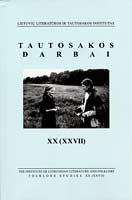Vaivorykštė lietuvių žodinėje tradicijoje
Rainbow in lithuanian oral tradition
Author(s): Nijolė LaurinkienėSubject(s): Customs / Folklore
Published by: Lietuvių literatūros ir tautosakos institutas
Keywords: Rainbow; oral tradition; Lithuanian folk narratives
Summary/Abstract: Lithuanian folk narratives, especially creation legends and place, or historical, legends and folk beliefs, have clearly preserved the archaic concept of the origin and essence of the rainbow. These folk narratives reveal what the rainbow is, what actions, events, mythical beings, time and space it is related to. However, the oral tradition has preserved a multi-sided image of the rainbow, related both to the early mythopoetic and to the later worldview. Therefore layers constituting concept of the rainbow are diachronic, yet they can be provisionally concentrated to present a database of the traditional culture regarding this natural phenomenon, and to reveal the way of thinking that has formed this culture. The rainbow is initially characterized by its names and definitions, which etymologically reveal the essential features of this phenomenon. Folk denominations of rainbow imply peculiarities of its form (bow), diversity of colors, and functions (drawing up waters; also, making peace), as well as its subordination to the mythical hero (God, laumė, Adam and Eve). This phenomenon is associated with those mythical beings, which can be described as closely related to aquatic sphere, especially to the water bodies located on Earth. Such mythical beings of watery nature like laumė, smakas (‘the dragon’) are often presented as personifications of the rainbow itself. Connections of rainbow with biblical figures (God and the first couple of humans, Adam and Eve) rest upon the legendary tradition stemming from the Old Testament, interpreted in folk narratives, however, with regards to the conception entrenched in the oral tradition. The mythical image of rainbow had been ascribed power to manipulate terrestrial and celestial waters, and to control their proportions. Rainbow could not only draw up waters, but also drag in animals and humans, who happened to get into the area of its special powers. Normally such objects would be returned to Earth afterwards, like waters, but occasionally they could be left on the sky to demonstrate some their attribute from above to the people gazing from the ground. The rainbow is perceived as mediator linking natural objects, celestial and terrestrial waters. Its image of a cosmic band indicates its uniting, world encompassing character.
Journal: Tautosakos darbai
- Issue Year: 2004
- Issue No: 27
- Page Range: 140-152
- Page Count: 13
- Language: Lithuanian

